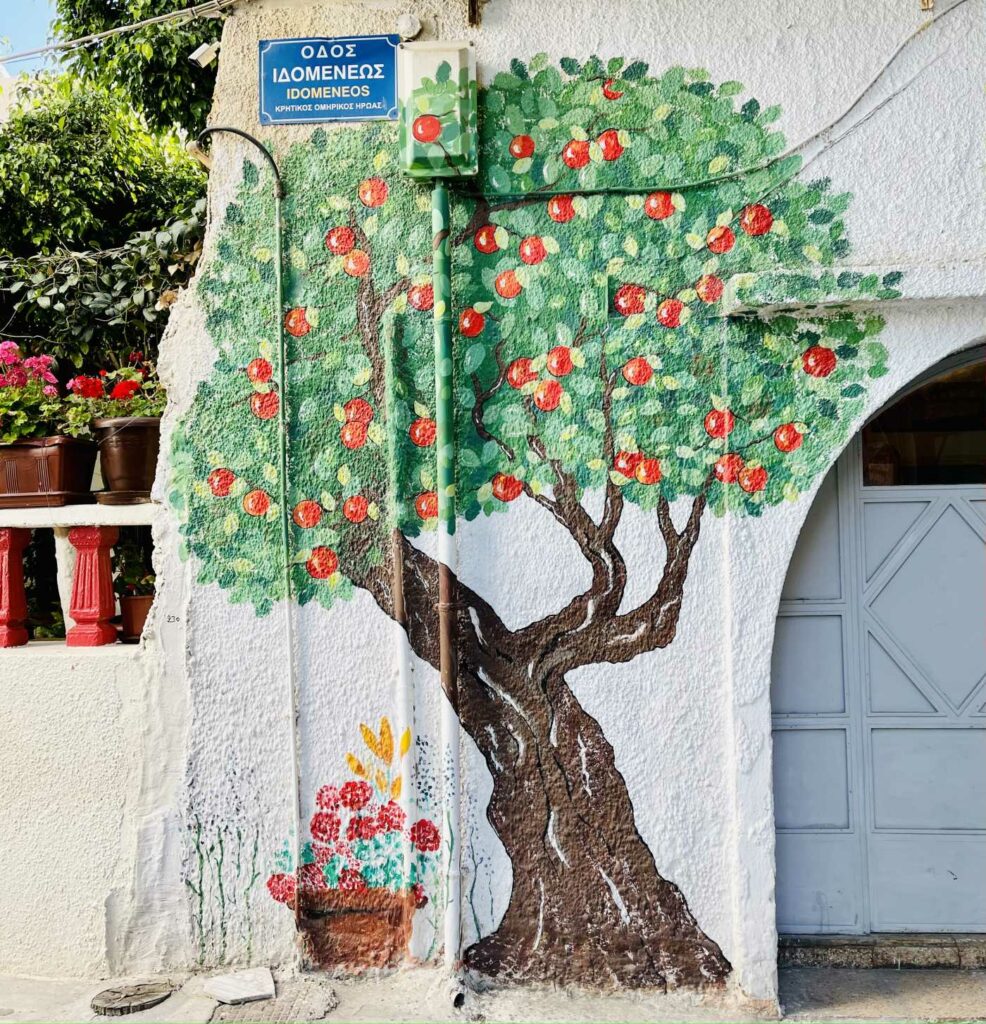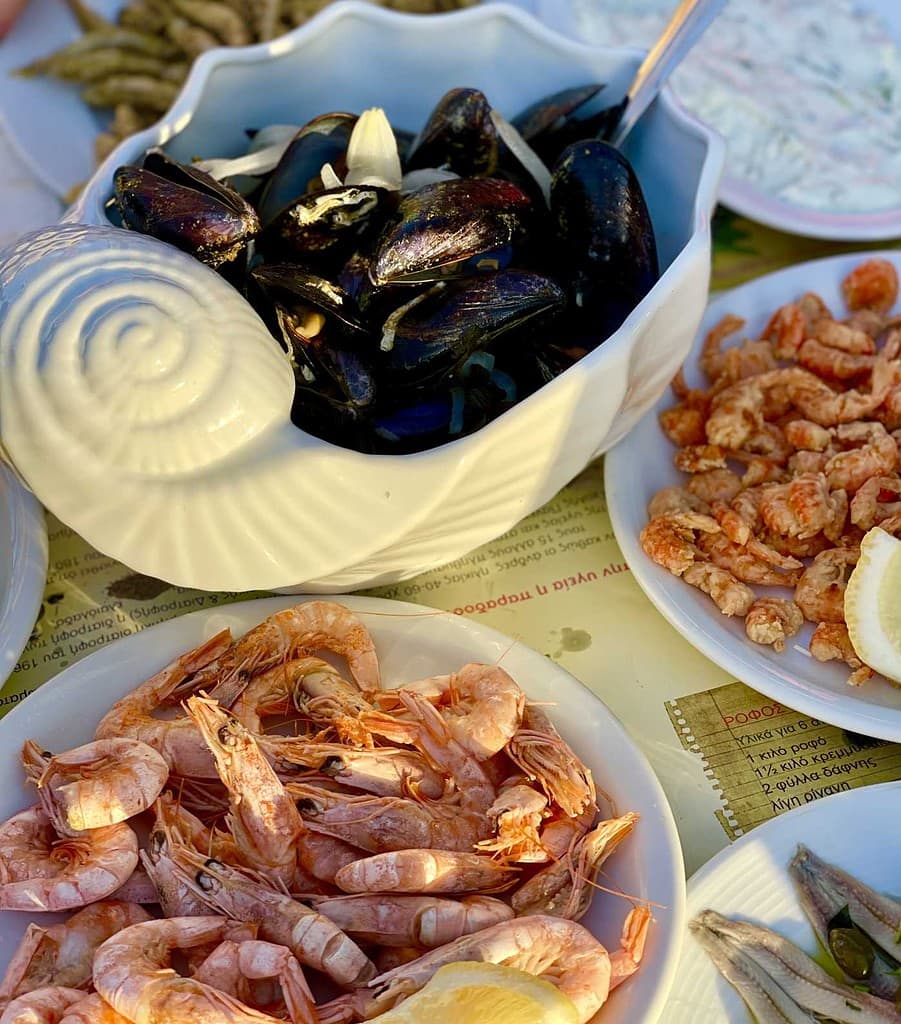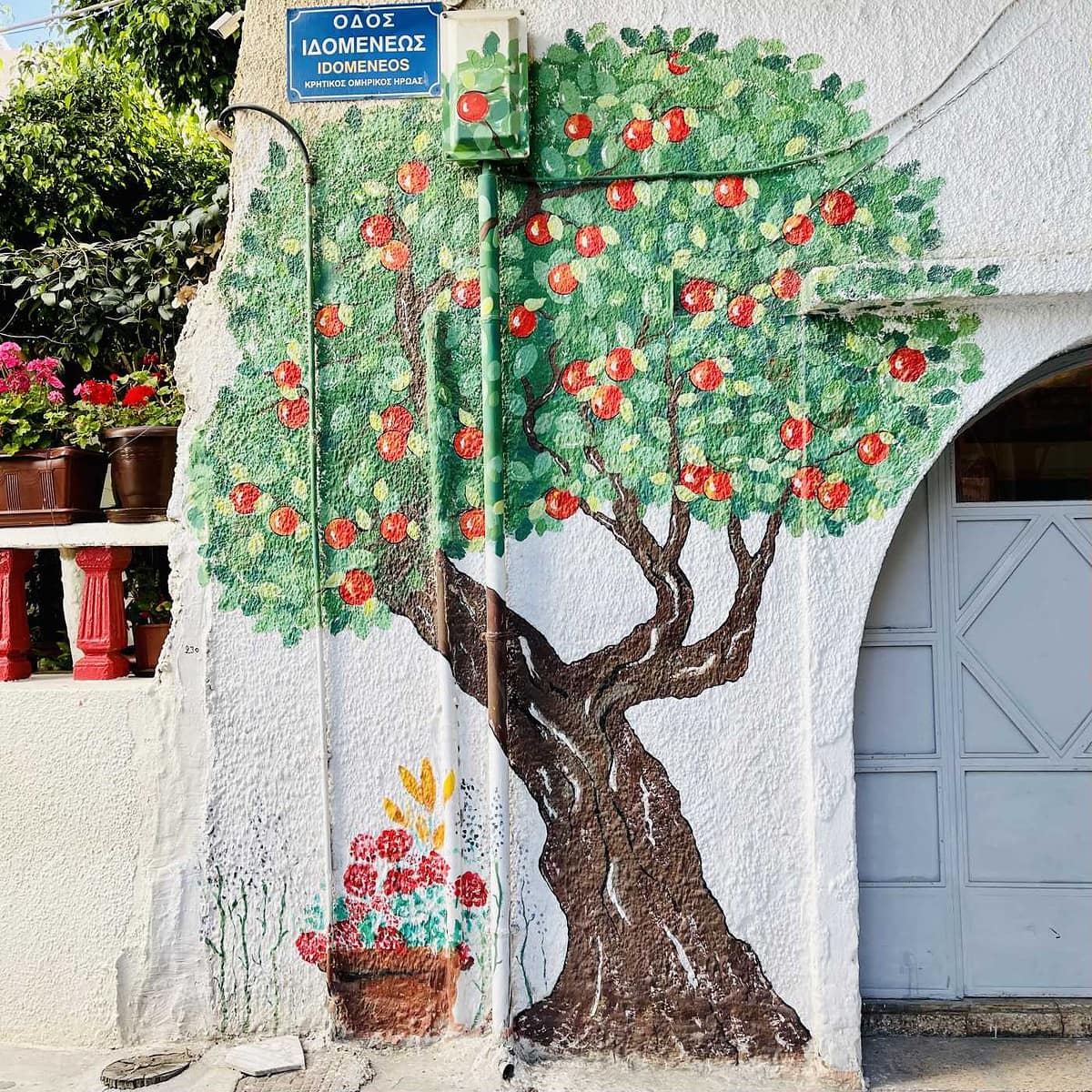Have you been to Crete yet? It’s THE foodie destination in Greece. You’ll never be hungry on this beautiful island. Thanks to the varied Cretan cuisine and the islands rich culinary traditions, you and your tastebuds are in for a very delicious vacation. Enjoy our recommendations for what to eat while visiting Crete.
Our number one Greece travel insider tip for great Cretan eats is to mix and mingle with the locals, be it at a café in Heraklion or a seaside tavern next to a gorgeous beach or buzzing harbor.
The Mediterranean diet, without a doubt, is one of the healthiest ways to eat — and also incredibly delicious, especially if you’re an omivore. With lots of healthy foods like organically grown vegetables and aromatic herbs, juicy fruits — always harvested when ripe thanks to short transportation routes, whole grains, beans, and nuts, plus lean proteins, especially seafood, combined with olive oil and minimally processed dairy products products like cheese and yoghurt (from cows, goats and sheep), Greek cuisine is a perfect example for a very balanced cuisines.
When in Crete: Eat what’s local and in season

Especially on the island of Crete, what’s served for breakfast, lunch and dinner focuses on what’s available locally and what’s in season.
“The traditional Cretan cuisine is considered to be one of the healthiest in the world”, confirm the local on Crete’s official website IncredibleCrete.com. Here, a whole XXL section is dedicated to the rich culinary traditions of Greek’s largest and most populated island. “The abundance and the variety of the products of the island through centuries has created a cuisine with unique taste, freshness and originality.” On Crete, your tastebuds will be on a delicious vacation, sampling dishes and products that are unique to not just the island, but also a specific region, sometimes village.
IncredibleCrete.com sums it up as follows: “Dairy products, honey, aromatic herbs, greens and so many other products of the Cretan mountains, are the basis for our Cretan cuisine. The Cretan nutrition is recognized nowadays by the international scientific community as the most representative and quality sample of the so-called Mediterranean Diet, which contributes to longevity and well-being.”
Must-trys for Foodies in Crete
- Cretan Olive oil and so-called table olives
Olive trees and the valuable fruits they yield have been part of Cretan life for more than 3,500 years. Centuries of history are part of the complex relationship between Cretans, their olive trees, and oil. The olive tree, olives and olive oil — all are an important part of everyday Cretan live. Far from being just food products, olives stands out as a symbol of Cretan civilization through the ages. The palace at Zakros features impressive olive harvest frescoes, vases, and whole olives dating from the 3rd millennium BC. Cretans have found various uses for the tree through time, and still use olive wood for heating, lighting, manufacturing household items, and preserving food. Olive oil and table olives are indispensable to any Cretan meal, and Cretans often exaggerate and consume large quantities on a daily basis. Olive oil also appears in every religious ceremony and is crucial to religion from birth to death. Raw or extra-virgin organic olive oil has been scientifically proven to promote overall health and longevity if used exclusively (excluding the use of other fats for cooking). Natural olive juice contains monounsaturated fatty acids and Vitamin E, which is said to increase «good cholesterol» (HDL) and therefore offer protection against heart disease and other vital organ failures. - Cretan cheeses and yoghurts from mainly goat and sheep’s milk
For centuries upon centuries, Cretan livestock farming tradition has resulted in a variety of excellent cheeses, yogurt, and crumb-like pasta called ksinochondros, all made from goat and sheep’s milk.
Cheese makers on Crete are highly regarded as they’re preserving traditional cheese-making methods, even in the context of modern, safer facilities, to offer unique traditional. ancient cheeses to present generations. Try Cretan graviera, ksinomizithra, pichtogalo from Chania, and ksigalo from Sitia (all awarded PDO status), plus there are plenty of other white and yellow Cretan Greek cheeses, such as anthotiro, mizithra, kefalotiri, malaka, staka, and tirozouli. - Cretan Greens and Indigenous Herbs
Edible wild greens grown abound on Cretan land and its fertile soils. They make for a very distinctive feature of the Cretan diet. As evidenced by traditional recipes, the Cretan diet requires that meat is always served with vegetables and greens. Leafy greens grow in heaths, rocky areas and also close to the shore. Their stems and roots often have a unique bitterish flavor. Horta is one of Sandra’s favorites. Think of it is as the word for “Greens of the day” (or week) and you’re sure in for something delicious and healthy when ordering this typical Cretan side. - Cretan Fruit – fresh or dried
Fruit-bearing trees, especially citrus trees, thrive in many areas of Crete. Oranges from Maleme in Chania have been awarded PDO status, though other famous varieties include oranges from the planes of Milopotamos and Fodele, cherries from Gerakari, bananas from Arvi, and apples from Lassithi Plateau. Plus, try local prickly pears, figs, sultanas and currants — fresh or died — have always been crucial both for the islanders’ diet and as an exportable product. Other vine fruits, such as the sweet and dense petimezi are also important in the Cretan cuisine as natural sweeteners. - Cretan Meat — grilled, smoked and cured
Small-scale livestock farming and the particular relief of the island called for flocks of smaller animals, usually grazing in mountain pastures — which made goat and sheep the dominant island meats of choice for centuries. And while you may not yet have tried either, we recommend you do so in Crete as the abundance and nutritional value of the indigenous herbs on which the flocks feed are unique. “That’s what makes their milk and meat so tasty, and their owners so proud”, confirm the locals. “Andikristo” is a traditional way of roasting lamb and goat meat, rooted in the shepherds’ way of preparing food without electricity or access to a full kitchen. Not into red meat? No worries, pork, chicken and rabbit are just as popular in Cretan cuisine nowadays. Apaki and siglina – specialty smoke-cured pork cuts – and vinegar sausages are must-trys. When in Italy you’d eat prosciutto and salami, in Spain you’d try jamón, right? - Cretan Bread and Dakos (aka double-baked Rusks)
Traditional Cretan bread and rusks are an important part of Cretan culture. Among the Minoan finds unearthed in the island are the earliest occurrences of simple barley bread. Quite a few traditional baking methods and recipes have survived to the present day, with some even acquiring a mystic tinge (such as the making of a specific rusk, the eptazimo). The wide variety of Cretan baked goods may be an essential part of the daily diet, though special breads are also associated with religious worship and local customs. The making of rusks is similar to that of regular bread, but the loaves are cut into slices and baked for a second time to dry out. Cretan rusk, known as Dakos, has been awarded PGI (Protected Geographical Indication) status. Dakos is the traditional ingredient for what we know as Greek salad, but is locally known as Cretan koukouvagia combining the crispy dark break ‘croutons’ with tomato and soft cheese for a delicious hearty salad, which makes dakos well-known across Greece. - Cretan Honey
Honey is one of the most important products of Crete. It wouldn’t be what it is without the wealth of fragrant plants and herbs thriving on the island. The product first appeared in ancient times. One of the most important finds from the Minoan era is the golden charm with two facing bees, which indicates that beekeeping activity existed early on. Honey replaces sugar as a sweetener in Cretan cuisine, and is very often combined with dairy products. The most popular types are thyme and pine-and-thyme honey, which are very fragrant and also very beneficial to human health. - Tsikoudia or Raki (for those of legal drinking-age)
Raki or known in Crete as tsikoudia, is THE spirit preferred by most Cretans. Awarded PGI status, this clear alcohol appears in every single aspect of social activity and every household on the island. Over time, tsikoudia has become a symbol of kindness and hospitality, a spirit which helps with introductions and starts new friendships. More than just a drink, it’s a means of communication between friends and strangers alike. This interesting spirit is produced with single grape marc distillation. Other fruits with a high sugar content are also suitable, such as figs, berries, and prunes, while the final product is sometimes infused with blueberries. - Cretan Fish, Seafood and Snails (Chochlios)
Surprisingly, Cretans favor meats over fish and seafood, but that shouldn’t stop you from enjoying the many ocean and sea creatures that thanks to a continuing fishing tradition in several small villages are brought to the restaurants and taverns fresh daily from the blue waters of Crete. Octopus lovers will be in food heaven here, with preparations including salads, grilled and also sun-dried octopi. When it comes to Cretan snails, they are prepared in a myriad of ways, cooked with chondros (wheat), in a tomato, zucchini and potato casserole; simply fried, or boubouristi style (boiled and then fried with herbs). - Cretan Wine with 11 Indigenous Grapes
Wine is an indispensable part of Cretan food culture and hospitality. Wine making traditions have been kept alive on the island for 4,000 years. Cretans have taken loving care of their vines to make wine or raisins. Almost every household in Crete produces its own wine and tsikoudia, in adequate quantities to cover the needs of the family and even give some away to friends. Taking care of the vine is deemed truly important by many Cretan families that own land and cultivate wine.
Boasting eleven unique indigenous grape varieties, Cretan producers are able to bottle single varietal wines, as well as intriguing blends with other European varieties that grow on the island. The most famous varieties that have found their way back into our glasses include both whites (vilana, vidiano, dafni, thrapsathiri, malvazia, moschato, plito) and reds (kotsifali, and most importantly, liatiko, and mantilari). And yes, there’s also Greek beer and even a growing craft beer movement, but we’ll get into that in another Greece travel insider post.

Want to bring some Cretan specialties to your table? Here’s a link to some great recipes for delicious eats from Crete that can be cooked at home. Did you know that you can bring some local foods home with you? Edible souvenirs like Cretan olive oil or honey make for wonderful presents or can be a great addition to your pantry at home. Always declare foods that you are bringing with you from your travels and never bring fresh fruits or vegetables.

